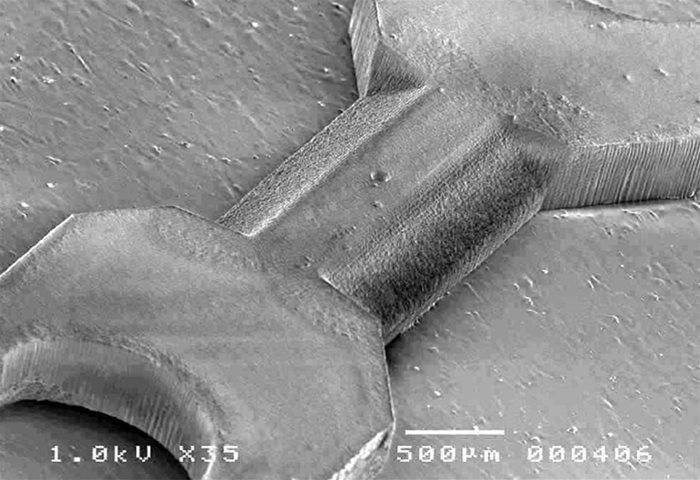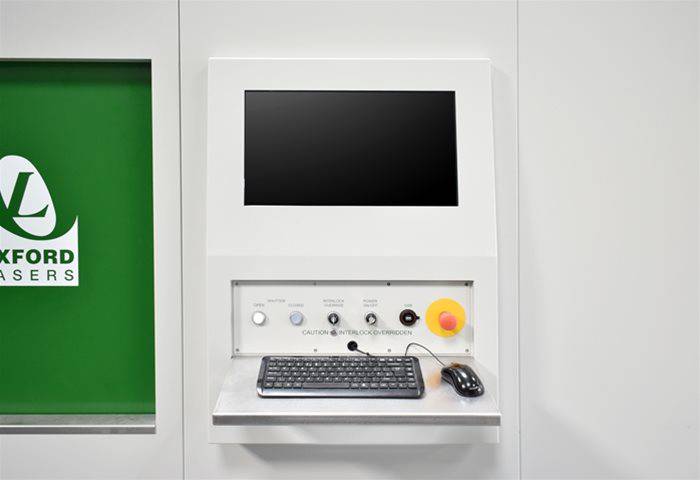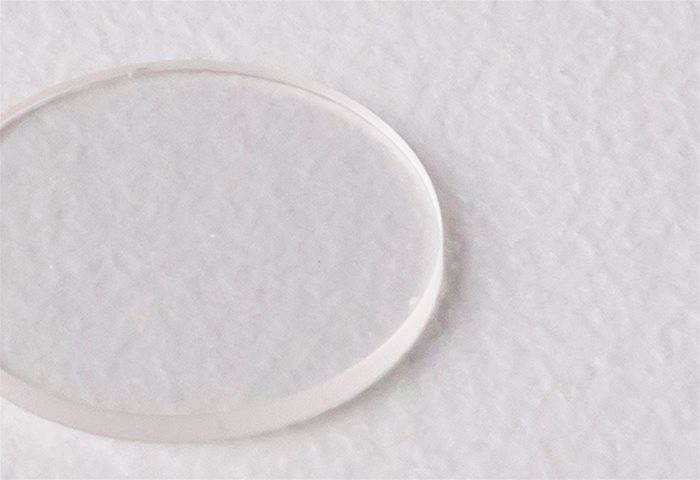Laser Micromachining Systems 세라믹 재료 미세가공 시스템
-
Laser micromachining can drill, mill, and cut ceramics with sub-micron precision.

Ceramics are generally extremely hard and tough materials. As such, conventional mechanical machining is difficult, slow and expensive. Tools wear out rapidly or break. This is an increasing problem as feature sizes and tolerances get tighter and so require finer tools. In contrast laser micromachining is a non-contact process, there is no tool wear and the effective tool size can be below 5 microns.
Laser micromachining can drill, mill, and cut ceramics with sub-micron precision. All engineering ceramics can be laser processed with features sizes in the range of microns to hundreds of microns. Many different types of ceramics can be laser processed including hard ceramics e.g. Alumina, Silicon Nitride, Aluminum Nitride, Carbides, as well as machinable ceramics e.g. Photoveel, Macor etc.

For ultra-high precision of ceramics, Oxford Lasers use short (nanosecond) and ultrashort (picosecond or femtosecond) pulsed lasers to achieve sub-micron dimensional repeatability where this is required. MORE DETAILS
A sample of ceramics we can machine include:
Alumina | Aluminium Nitride | Machinable Ceramics | PZT | Silicon Nitride | Plus many more...
Transparent materials cover a wide range of substances from glasses e.g. Borosilicate through to transparent ceramics e.g. Sapphire.
As a class of materials, transparent substrates can be traditionally difficult to machine. They can range from the very hard materials such as gorilla glass through to soft polymers with low melting points, for example polycarbonates.

As such, laser micromachining of these materials can prove more difficult than many other materials due to their transparent optical properties. However, with the correct choice of laser, high quality high precision micromachining is possible. The lasers of choice tend to be ultrafast lasers in either in the picosecond or femtosecond regime. These lasers often perform processing tasks that are just not possible with any other traditional machining techniques.
Feature sizes of a few microns and upwards are possible when machining materials such as diamond, transparent conductive oxides (TCOs), as well as polymers such as PET etc and many more.
A sample of transparent materials we can machine include:
Fused Silica | Glass (Borosilicate) | Toughened Glass | Sapphire | Plus many more...
X-ray fluorescence energy dispersive general purpose spectrometer BRA-135F
-
Detection of 10 basic components of whiteware materials SiO2, Al2O3, Fe2O3, MgO, CaO, Na2O, K2O, TiO2, P2O5, MnO) by wave dispersion X-ray fluorescence spectrometry is provided in standard [ASTMC1605 - 04(2009). Standard Test Methods for Chemical Analysis of Ceramic Whiteware Materials Using Wavelength Dispersive X-Ray Fluorescence Spectrometry].
Refractories and High-Temperature Ceramics
X-ray fluorescence energy dispersive general purpose spectrometer BRA-135F
-
Essential auxiliary materials used as lining for ferrous and non-ferrous metals and alloys furnaces are refractories.
Refractories are rocks, minerals and their mixtures with the fusion temperature of over 1500ОС that do not interact with molten metals. Detectable elements in various types of refractories are Mg, Na, Al, Si, K, Ca, Ti, Cr, Fe, Zr. Requirements to methods for detection of these elements in these refractories are described in the standard [GOST 2642.0-86. Refractories and refractory raw material. General requirements to analysis methods.]. All these elements may be determined with spectrometer BRA-135 according to the procedure similar to procedure of rock silicate analysis method.
Currently the Russian Federation standard for X-ray fluorescence of refractory materials and high-temperature ceramics GOST R “Refractories. X-ray fluorescence analysis", which is a translation of the international standard [ISO 12677:2003 Chemical analysis of refractory products by X-ray fluorescence (XRF) – Fused cast bead method] is being developed. The goal of Russian Federation’s national standard development is direct application of international standard ISO 12677, with due regard of specific features of refractories X-ray fluorescence analysis in the Russian Federation. The standard allows for detecting contents of Na2O, MgO, Al2O3, SiO2, P2O5, SO3, K2O, CaO, TiO2, Cr2O3, Mn3O4, Fe2O3, Co3O4, NiO, ZrO2, WO3, BaO, SrO, HfO2, Y2O3, CeO2, La2O3, SnO2 within the range of 0.01% to 100%.
With specific features of Russian enterprises taken into account, this standard allows both the analysis of powder samples and sample preparation through fusion with lithium pyroborate, and concentration ranges of some elements have been changed. Analysis reproducibility and precision is better for fused samples, but analysis of compacted powder samples is allowed on most cases as well.
세라믹 열전도도측정기 (Thermal Conductivity Meter)
-
ISO 22007-2 2008 Transient Plane Heat Source method
Universal Testing Machine (UTM) from Testresources, USA
-
Ceramics are composed of compounds of metals and non metals and may be crystalline or partly crystalline. They are characterized as brittle, hard, strong in compression, and weak in shearing, tension and impact. These materials are also very resistant to both corrosion and very high temperatures and can be designed to either insulate against or selected to conduct electricity. Ceramics have a wide range of applications most notably in industries that require materials to withstand large compressive forces or intense heat exposure for extended periods of time.
Ceramics Testing:
Testing ceramics helps determine if they are suited for specific applications. Typically this involves a series of tests to measure the material’s mechanical properties. These properties include the yield strength, ultimate strength, tensile strength, compressive strength, flexural strength, fracture strength, hardness, fracture resistance and creep rate. With the knowledge of these values the behavior that is expected from the ceramic during the application can be predicted and it can be shown if it will succeed or fail.
Common Ceramics Test Methods:
There are many different tests that can be performed upon ceramics but the most common and important are those that involve compression, tension, flexural, and fracture mechanics. Because of the way that ceramics are constructed they generally posses vary high compressive strengths and will most often fail due to tensile, flexural or fracture forces; therefore it is very important to test these properties. Each property may also be tested using conventional methods, creep mechanics or cyclic (fatigue) methods.
Material Testing Specimens:
Depending on the method of testing a ceramic test sample can come in several different forms. For compression testing a ceramic sample is usually in the sample of a simple brick, cube or cylinder. Flexural and fracture testing require the sample to be smaller than compression testing but it is still rectangular in nature with the flexure sample generally as a thin rectangle and the sample for fracture ranging from a beam to a brick. A ceramic sample for tensile testing presents interesting obstacles as they are very brittle in nature and prone to fracturing when loaded improperly. The sample is generally the same as other tensile samples with the exception of the ends which are usually formed as button headed to fit into specially designed grips to avoid any incidental failure.
Related Articles
- Tensile Test Machines for Ceramics
- How to Choose Equipment for Tensile Testing Ceramics
- Fracture Toughness Test Equipment for Advanced Ceramics
- Flexural Bend Test Fixtures and Equipment for Ceramics
- How to Select Compression Test Equipment for Ceramics
- Equibiaxial Ring on Ring Ceramic composite flexural strength per ASTM ISO
- Ceramic High Temperature Material Testing Equipment 1,000°C (1,800°F) | Ceramics Research Spotlight
- Monolithic Ceramics Tensile Test Equipment
- Modulus of Rupture and Creep Test Equipment for Ceramics at 1,700°C (3,100°F)
Applicable Standards
- ASTM C1161 Flexural Bend Ceramics Test Equipment
- ASTM C1211 Flexural Testing for Ceramics
- ASTM C1273 Tensile Ceramic Test Equipment
- ASTM C1291 Tensile High Temperature Ceramics Test Machine
- ASTM C133 Crush Modulus Rupture Refractories Test Equipment
- ASTM C1361 Tension Tension Fatigue Ceramics Test Machine
- ASTM C1399 Residual Strength Fiber-Reinforced Concrete Test Equipment
- ASTM C1421 Fracture Toughness Ceramics Test Machine
- ASTM C1424 Compression Ceramics Test Machine
- ASTM C1499 Equibiaxial Flexural Ceramics Test Equipment
- ASTM C1550 Flexural Toughness Testing of Fiber Reinforced Concrete
- ASTM C1557 Tensile Fibers Test Equipment
- ASTM C158 Flexural Bend Testing for Glass
- ASTM C1674 Ceramic Flexural Strength Test Equipment
- ISO 14125 Plastic Composites Flexure Bend Test Machine
- ISO 14126 Compression Fiber-Reinforced Plastic Composites Test Machine
- ISO 14130 Flexure Short Beam Plastic Composites Test Equipment
- ISO 22214 Fine Ceramics Cyclic Bending Fatigue Testing
하기